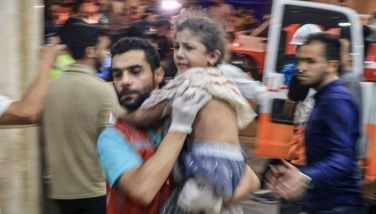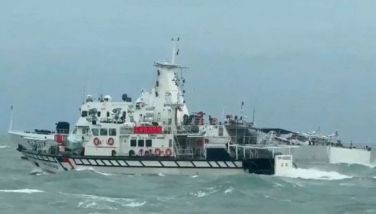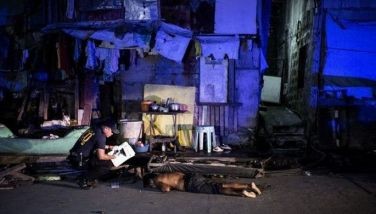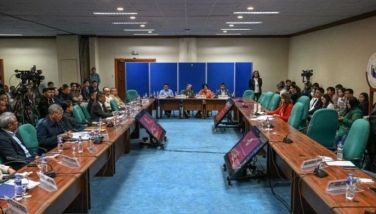Looting, gunfire break out in typhoon-hit city
TACLOBAN — Mobs overran a rice warehouse on the island worst hit by the Philippine typhoon, setting off a wall collapse that killed eight people and carting off thousands of sacks of the grain, while security forces yesterday exchanged gunfire with an armed gang.
The incidents in or close to the storm-ravaged city hosting international relief efforts add to concerns about the slow pace of aid distribution and that parts of the disaster zone are descending into chaos.
Five long days after Typhoon Haiyan wasted the eastern seaboard of the Philippines, the cogs of what promises to be a massive international aid effort are beginning to turn, but not quickly enough for the some 600,000 people displaced, many of them homeless, hungry and thirsty.
"There's a bit of a logjam to be absolutely honest getting stuff in here," said UN staffer Sebastian Rhodes Stampa against the roar of a C-130 transport plane landing behind him at the airstrip in Tacloban, one of the hardest-hit cities.
"It's almost all in country — either in Manila or in Cebu, but it's not here. We're going to have a real challenge with logistics in terms of getting things out of here, into town, out of town, into the other areas," he said. "The reason for that essentially is that there are no trucks, the roads are all closed."
Planes, ships and trucks were all on their way to the region, loaded with generators, water purifying kits and emergency lights — vital equipment needed to sustain a major relief mission. Airports were reopening in the region, and the US military said it was installing equipment to allow the damaged Tacloban aiport to operate 24-7.
Tacloban's mayor, Alfred Romualdez, urged residents to flee the city because local authorities were having trouble providing food and water and maintaining order, The New York Times reported. He said the city was in desperate need of trucks to distribute relief shipments that were accumulating at the city's airport as well as equipment to pull decaying corpses from the rubble.
Eight people were crushed to death when the mob stormed a rice warehouse around 24 kilometers (15 miles) from Tacloban on Tuesday and carried off thousands of sacks of grain, according to National Food Authority spokesman Rex Estoperez.
On yesterday, gunfire broke out close to the city's San Juanico bridge on yesterday between security forces and armed men, but the circumstances were unclear, according to footage on local TV.
Since the storm, people have broken into homes, malls and garages, where they have stripped the shelves of food, water and other goods. Authorities have struggled to stop the looting. There have been unconfirmed reports of armed gangs of robbers operating in a systematic manner.
An 8 p.m. to 5 a.m. curfew was in place across the region. Despite incidents, police said the situation was improving.
"We have restored order," said Carmelo Espina Valmoria, director of the Philippine National Police special action force. "There has been looting for the last three days, but the situation has stabilized."
The death toll rose to 2,344, according a national tally kept by the disaster agency. That figure is expected to rise, perhaps significantly, when accurate information is collected from the entirety of the disaster zone, which spreads over a wide swath of the eastern and central Philippines but appears to be concentrated on two main islands, Leyte and Samar.
The congressman for Eastern Samar province, a coastal region that bore the full force of the storm, said 211 had been killed there and 45 were missing. He said some villages have been wiped out, with practically no structures standing. In one town, bodies remain lying on the road because help has not come to retrieve or bury them. Other towns have conducted mass burials.
"The situation there was horrible," Ben Evardone told a local television station. "Some communities disappeared, entire villages were wiped out. They were shouting 'food, food, food!' when they saw me."
US Brig Gen. Paul Kennedy promised a response akin to the widely praised US military one after the 2004 Asian tsunami, when fleets of helicopters dropped water and food to hundreds of isolated communities along the coast.
"You are not just going to see Marines and a few planes and some helicopters," Kennedy said. "You will see the entire Pacific Command respond to this crisis."
A Norwegian ship carrying supplies left from Manila, while an Australian air force transport plane took off from Canberra carrying a medical team. British and American navy vessels are also en route to the region.
At the Tacloban airport, makeshift clinics have been set up and thousands of people were waiting for a flight out. A doctor said supplies of antibiotics and anesthetics arrived Tuesday for the first time.
"Until then, patients had to endure the pain," said Dr. Victoriano Sambale.
Relief officials said comparing the pace of this operation to those in past disasters was largely pointless because each posed unique challenges.
In Indonesia's Aceh, the worst-hit region by the 2004 tsunami, relief hubs were easier to set up than in Tacloban. The main airport there was functioning 24-7 within a couple of days of the disaster. While devastation in much of the city of Banda Aceh was total, large inland parts of the city were undamaged, providing a base for aid operations and temporary accommodation for the homeless.
- Latest
- Trending

































